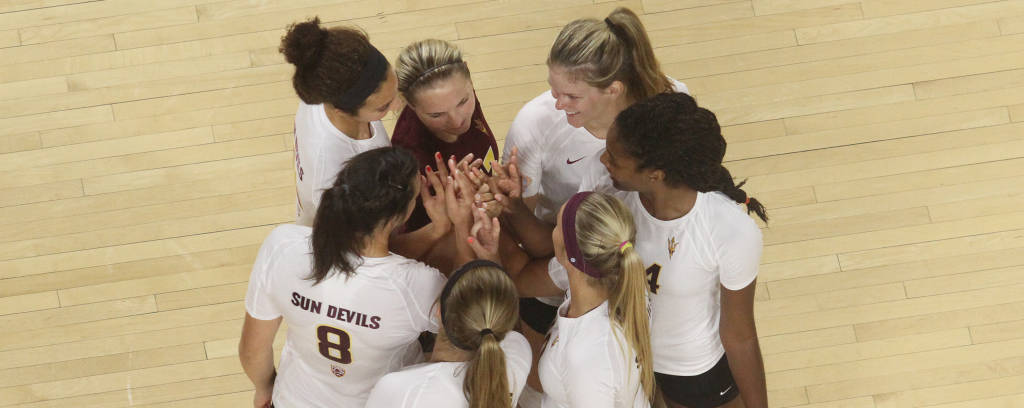
(Photo: ASU Athletics)
The change in mentality for the No. 18 Arizona State Sun Devils has been well documented. They are approaching each match, each set and each point in a more disciplined manner, something that was lacking last season.
With an improved mental approach, ASU has produced positive results in tough environments such as their win over then-No. 17 Hawaii in Honolulu as well as their five-set comeback victory over Northern Illinois last weekend in their second match of the day, following their first loss of the season against Louisville.
However, as much as any team can improve their mental strength, they still need to physically perform on the court.
Part of ASU’s struggles in the beginning of Pac-12 play in 2013 was their lack of a reliable attacking option other than junior outside hitter Macey Gardner.
“There were moments last year when it was clearly – it was evident to everybody – that it was the Macey-show, the Macey offensive show and maybe a little scattering of (BreElle Bailey), but it was mainly (Gardner),” ASU head coach Jason Watson said.
To get a better understanding of how much Gardner was depended upon, here is a breakdown of how much she accounted for ASU’s total attack attempts (4,394) last season as well as the rest of ASU’s current starters:
Clearly, Gardner was relied on heavily during the 2013 season, but it was with good reason. Gardner has consistently been a dominant attacker from the moment she donned a Sun Devil uniform.
“There’s an enormous amount of comfort in setting (Gardner). You like your chances when you set Macey,” Watson said. “On the flip side of that, everybody knows you’re going to set (Gardner), so it’s nice to see (Bailey) get going.”
Part of the offensive imbalance had to do with not having a consistent second option, but part of it was also the amount of trust junior setter Bianca Arellano had in the rest of her hitters.
Now, with a year of familiarity under their belt, the Sun Devil offense has helped ASU to blaze to an 8-1 start to this season. Thus far, the balance has been evident both on tape and through the stats.
Of the total attack attempts (1050), here is the same percentage breakdown for this season:
Most notably, the middles are being utilized more by a significant amount in comparison with last season. The biggest difference is when in transition, Arellano is looking to Follette and Binns with more purpose, and the middles are audibly calling their sets so Arellano can find them.
Follette has been increasingly efficient throughout her career in Tempe and is currently hitting an efficient .336 percent, and she has only committed a total of 21 attacking errors.
“You can tell that (Follette) provides significant results for our team – offensively, defensively, energy-wise,” Arellano said.
All things considered, Binns has become a near-equal to Follette in her production as well. Her experience with the USA Collegiate National team over the summer has proven to be invaluable.
“(Binns) has matured immensely,” Watson said. “She’s a different student-athlete than when she got here. She’s talking about getting a master’s degree. That’s a miracle.”
Arellano has also noticed the difference in Binns and is trying to award her by feeding her sets on a regular basis.
“That’s been something I’ve been working on – trying to connect with Mercedes,” Arellano said.
Another big factor in ASU’s offensive balance is the seemingly consistent production from Bailey in their first nine matches. Bailey has found a home on the right side, and continues to take on a bigger workload as she transitions from a player who shows flashes of potential to one that is a go-to attacker for the Sun Devils.
“I see a big confidence boost from (Bailey),” Arellano said. “I mean, working with her, coming in the spring early definitely helped and then having a season under our belts helped, but there’s this new face she has, and everybody should be looking out.”
Bailey, a former middle blocker throughout her entire prep career, has focused on becoming a more well-rounded volleyball player, and her improvement has been evident to her teammates as well as to herself.
“We’re able to run a lot of different sets, and I’m a lot more diverse than I was last year, and my sets are actually a lot faster than they were last year,” Bailey said.
Up and down ASU’s roster, the talent can clearly stack up with any other roster in the Pac-12. In past seasons, teams like No. 1 Stanford and No. 5 Washington have exploited ASU has been taking advantage of their mental mistakes as well as keying in on Gardner.
With the development and diversification of every ASU attacker, this could be the most equipped squad Watson has assembled going into conference season. Because of the increased use of the middles and the more consistent production from both Bailey and Willey, Gardner can focus on being a dominant attacker instead of carrying a burden of being ASU’s only reliable hitter.
“We hope (the balance) continues. We certainly hope that we’re not always Macey-driven,” Watson said. “But when it gets into these matches, it’s nice to have someone like Macey that can kind of step up and score a bunch of points and lead your team.”
Once conference play rolls around, scouting reports get more intricate and the teams who can make the most adjustments are the ones who succeed. Last season, ASU didn’t necessarily have the tools to make those adjustments. Now, because of the level of diversity on the offensive side of the ball, they have the flexibility to adapt to each situation they encounter, and that flexibility should improve given the nature Watson believes his team breeds.
“They’re so into just getting better,” Watson said.
You can reach Zac Pacleb on Twitter @ZacPacleb or via email at zacpacleb@gmail.com





You must be logged in to post a comment.